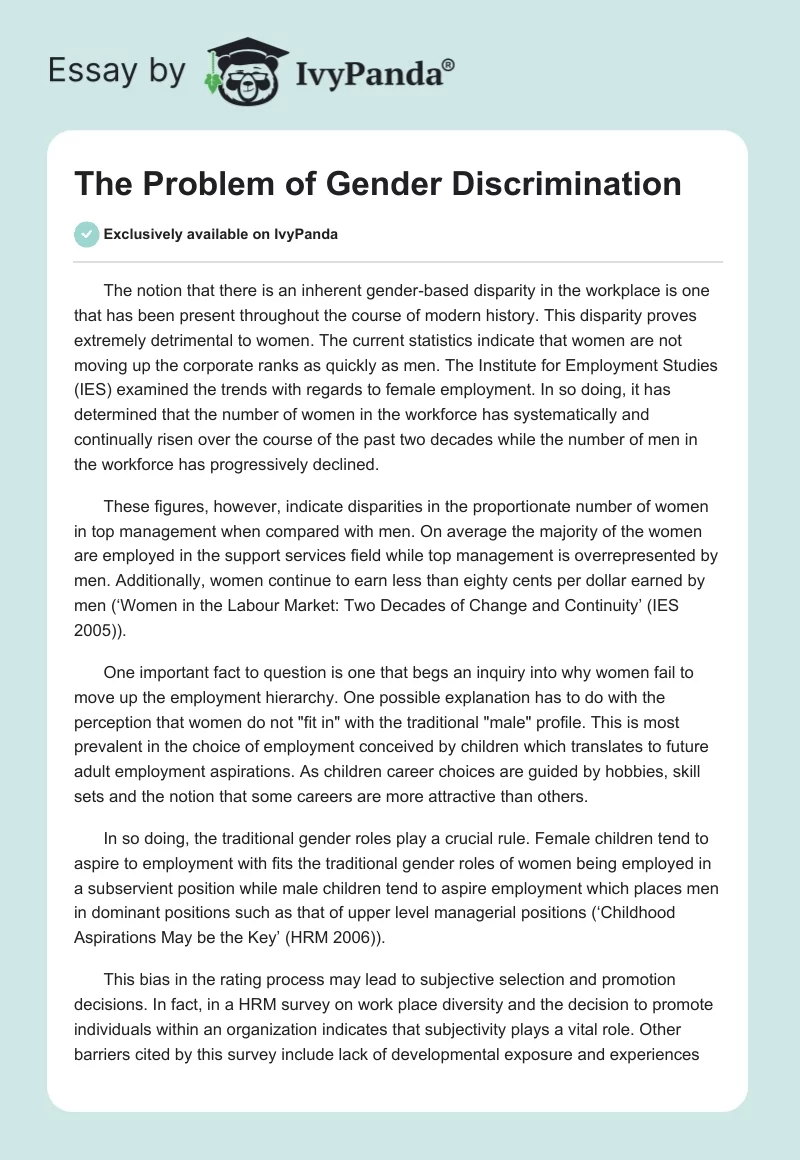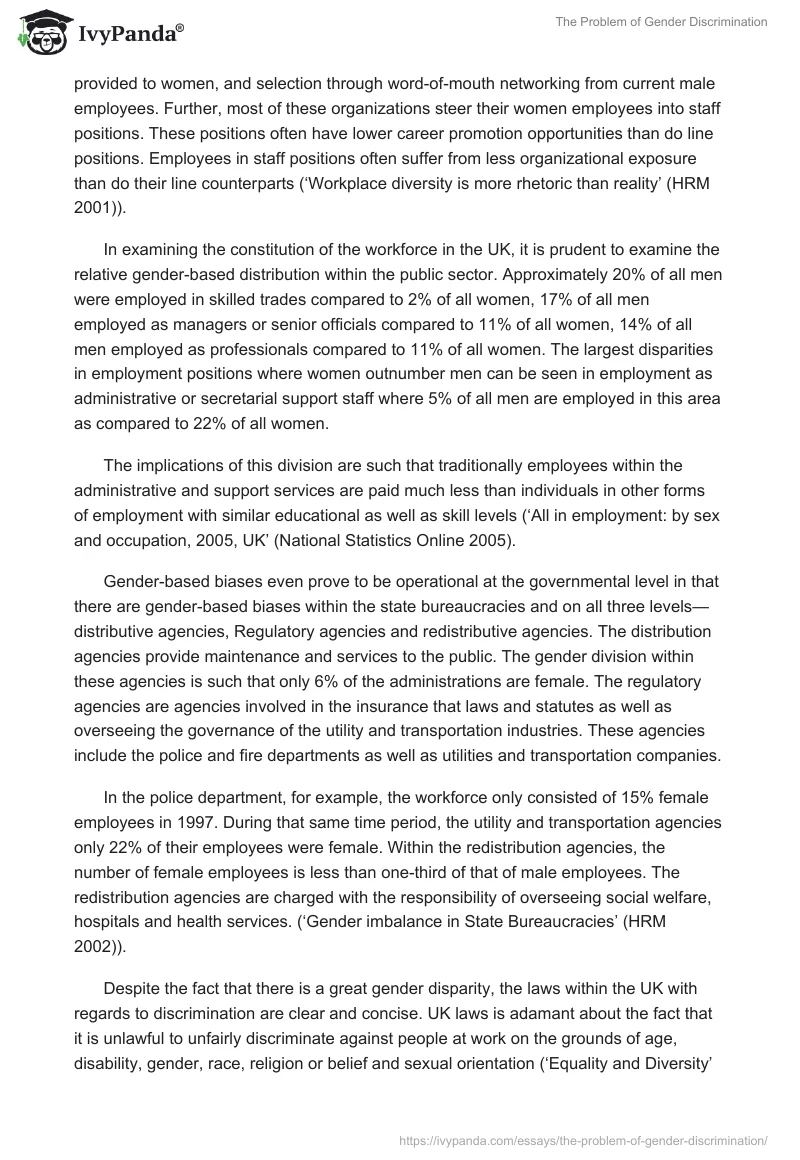The notion that there is an inherent gender-based disparity in the workplace is one that has been present throughout the course of modern history. This disparity proves extremely detrimental to women. The current statistics indicate that women are not moving up the corporate ranks as quickly as men. The Institute for Employment Studies (IES) examined the trends with regards to female employment. In so doing, it has determined that the number of women in the workforce has systematically and continually risen over the course of the past two decades while the number of men in the workforce has progressively declined.
These figures, however, indicate disparities in the proportionate number of women in top management when compared with men. On average the majority of the women are employed in the support services field while top management is overrepresented by men. Additionally, women continue to earn less than eighty cents per dollar earned by men (‘Women in the Labour Market: Two Decades of Change and Continuity’ (IES 2005)).
One important fact to question is one that begs an inquiry into why women fail to move up the employment hierarchy. One possible explanation has to do with the perception that women do not “fit in” with the traditional “male” profile. This is most prevalent in the choice of employment conceived by children which translates to future adult employment aspirations. As children career choices are guided by hobbies, skill sets and the notion that some careers are more attractive than others.
In so doing, the traditional gender roles play a crucial rule. Female children tend to aspire to employment with fits the traditional gender roles of women being employed in a subservient position while male children tend to aspire employment which places men in dominant positions such as that of upper level managerial positions (‘Childhood Aspirations May be the Key’ (HRM 2006)).
This bias in the rating process may lead to subjective selection and promotion decisions. In fact, in a HRM survey on work place diversity and the decision to promote individuals within an organization indicates that subjectivity plays a vital role. Other barriers cited by this survey include lack of developmental exposure and experiences provided to women, and selection through word-of-mouth networking from current male employees. Further, most of these organizations steer their women employees into staff positions. These positions often have lower career promotion opportunities than do line positions. Employees in staff positions often suffer from less organizational exposure than do their line counterparts (‘Workplace diversity is more rhetoric than reality’ (HRM 2001)).
In examining the constitution of the workforce in the UK, it is prudent to examine the relative gender-based distribution within the public sector. Approximately 20% of all men were employed in skilled trades compared to 2% of all women, 17% of all men employed as managers or senior officials compared to 11% of all women, 14% of all men employed as professionals compared to 11% of all women. The largest disparities in employment positions where women outnumber men can be seen in employment as administrative or secretarial support staff where 5% of all men are employed in this area as compared to 22% of all women.
The implications of this division are such that traditionally employees within the administrative and support services are paid much less than individuals in other forms of employment with similar educational as well as skill levels (‘All in employment: by sex and occupation, 2005, UK’ (National Statistics Online 2005).
Gender-based biases even prove to be operational at the governmental level in that there are gender-based biases within the state bureaucracies and on all three levels—distributive agencies, Regulatory agencies and redistributive agencies. The distribution agencies provide maintenance and services to the public. The gender division within these agencies is such that only 6% of the administrations are female. The regulatory agencies are agencies involved in the insurance that laws and statutes as well as overseeing the governance of the utility and transportation industries. These agencies include the police and fire departments as well as utilities and transportation companies.
In the police department, for example, the workforce only consisted of 15% female employees in 1997. During that same time period, the utility and transportation agencies only 22% of their employees were female. Within the redistribution agencies, the number of female employees is less than one-third of that of male employees. The redistribution agencies are charged with the responsibility of overseeing social welfare, hospitals and health services. (‘Gender imbalance in State Bureaucracies’ (HRM 2002)).
Despite the fact that there is a great gender disparity, the laws within the UK with regards to discrimination are clear and concise. UK laws is adamant about the fact that it is unlawful to unfairly discriminate against people at work on the grounds of age, disability, gender, race, religion or belief and sexual orientation (‘Equality and Diversity’ (Advisory Conciliation and Arbitration Service n.d.). In instances where there is a dispute with regards to whether discrimination takes place, the Advisory Conciliation and Arbitration Service (ACAS) takes an active role in resolving this dispute. The ACAS is an advisory service which provides advice to employers with regards to employment law and it encourages employers and unions to utilize the best practice model for conducting business.
The Sex Discrimination Act (SDA) of 1975 outlaws any direct or indirect act of discrimination based on gender and precludes the victimisation of any individual who attempts to assert his/her rights under this act. In addressing the gender disparity the Equal Pay Act (EPA) of 1970 delineates that individuals who are employed in comparable positions should received comparable compensation irrespective of gender (‘Women and Equality Unit’, (ACAS n.d.)).
In cases where an individual feels that he/she has been discriminated against based on gender, a claim may be brought against his/her employer. In the claim the individuals may seek remuneration for injured feelings, loss earnings, personal injury and the cost of seeking alternate employment as well as the interest on their lost compensation.
The Equality and Human Rights Commission also plays a vital role in assuring that the laws are complied with. It is a non-departmental public body (NDPB) which was established under the Equality Act 2006 and works arduously to assure that equal opportunities are offered to all within the workplace irrespective of age, disability, gender, race, religion or belief and sexual orientation.
The Equality and Human Rights Commission works to enforce the law, Influence the development of the law and government policy, promote good business practice, foster better employer/employee relationships and develop evidence with regards to claims (‘Equality and Human Rights Commission—What we do’, (Equality and Human Rights Commission n.d.)).
The laws with regards to discrimination based on gender are both clear and comprehensive. Under the law, discrimination is strictly prohibited. The specific laws are delineated in the Sex Discrimination Act of 1975 and the Equal Pay Act. As a means of assuring that the laws are upheld, the Advisory Conciliation and Arbitration Service and the Equality and Human Rights Commission take an active role.
Despite there arduous efforts, the statistics are such that there is an underlying disparity as illustrated by the data compiled by the Human Resources Management, Institute for Employment Studies and National Statistics Online. This causes one to examine whether there it is possible to reconcile the theoretical notion of gender equality and its practical application. One has to really wonder where we go from here.
References
Advisory Conciliation and Arbitration Service. (n.d.) Equality and Diversity. Web.
Advisory Conciliation and Arbitration Service. (n.d.) Women and Equality Unit. Web.
Equality and Human Rights Commission. (n.d.) Equality and Human Rights Commission—What we do. Web.
HRM Guide. (2006). Childhood Aspirations May be the Key. Web.
HRM Guide. (2002). Gender imbalance in State Bureaucracies. Web.
HRM Guide. (2001). Workplace diversity is more rhetoric than reality. Web.
Institute for Employment Studies. (2005). Women in the Labour Market: Two Decades of Change and Continuity. Web.
National Statistics Online (2005). All in employment: by sex and occupation, 2005, UK. Web.


